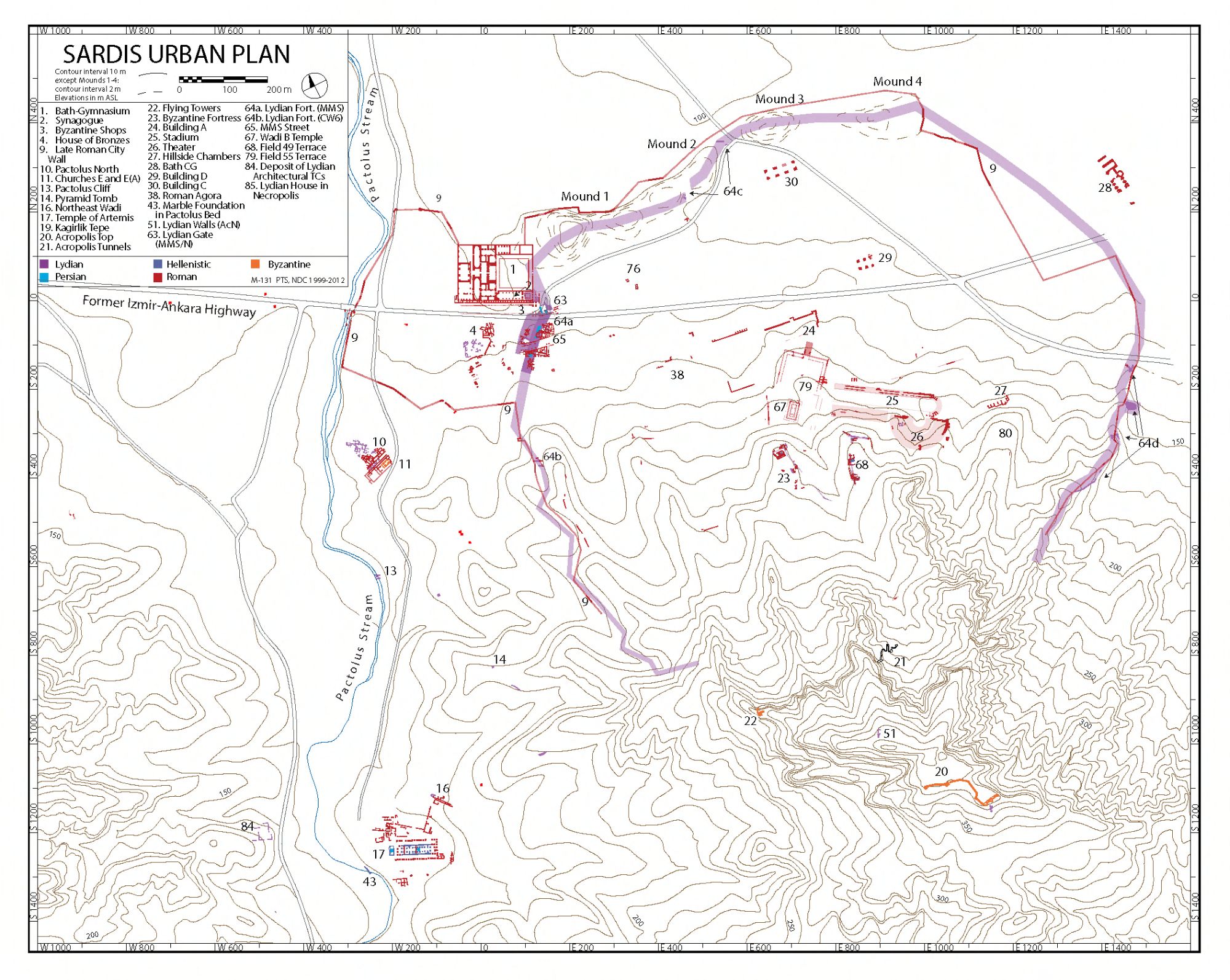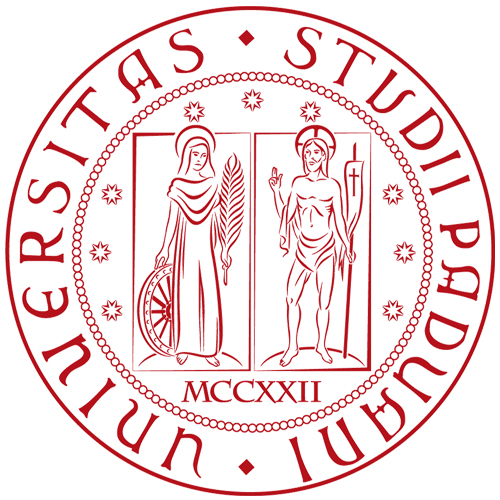
PHRC003 : Dossier concerning the cultic honours for Queen Laodike at Sardis - Lydia (Summer 213 BC) Decree
Permanent ID http://s.phrc.it/phrc003
Images:
Photo 1: Plan of ancient Sardis, from sardisexpedition.org

Text constituted from: Gauthier 1989, p. 47-48, no. 2A-C (fragments 63.121 and 63.101; SEG XXXIX 1284), and no. 3 (fragment 63.120; SEG XXXIX 1285), with French trans. and extensive commentary. In publishing text 3 after text 2C, we take into account the remarks of Knoepfler 1993, p. 26-43, especially as regards the interpretation of Gauthier's texts no. 2C and 3 as parts of the same letter of Antiochos; this hypothesis had already been formulated by Gauthier, p. 78-79, who, however, preferred to consider the two texts as separate.
Other editions: Ma 2002, p. 285-287 and 287-288, no. 2-3, publishes and discusses the two documents separately (English trans.).
See also: L. Robert in Hanfmann 1983, p. 111-112 (French trans.); Bringmann - von Steuben 1995, p. 298-300, no. 260 [E] II-III (German trans.); Kotsidu 2000, p. 335, no. 233 [E]; Ma 2002, p. 61-62, 202-203; Virgilio 2003, p. 234-236, no. 8 (Italian trans.).
Images: for the fragments 63.121 and 63.101, see Gauthier 1989, Pl. II-III; for fragment 63.120, Gauthier 1989, Pl. IV.
Further bibliography: Boffo 1985, p. 145-150; Nafissi 2001 (on I.Iasos 4); Capdetrey 2007, p. 140, 316, 421; Caneva 2014b, p. 25-57; Bencivenni 2015; D'Agostini 2018, p. 59-81.
Decree of the Sardians (Gauthier no. 2A)
Ἡρακλείδης
Σωκράτου
εἶπεν·
ἐπε[ιδὴ 15............... τ?]ὴν
ἐπι
-
στολ[ὴν τ]ὴν
γραφεῖσαν
παρὰ τῆς βασιλίσση[ς πρός τε? τὴ?]ν βουλὴν
καὶ τὸν δῆμον
ὑπὲρ τῶν τιμῶν
τῶν ἐψηφισμένων ὑπὸ τοῦ
δήμου τῶι τ[ε?]
βασιλεῖ καὶ τῆι
βασιλίσσηι καὶ τοῖς
τέκνοις
αὐτῶν ἀναγράψαι
εἰς τὴν
5
παραστάδα
τοῦ ναοῦ τοῦ ἐν
τῶι Μητρώιωι·
δεδόχθαι τῆι
βουλῆι καὶ τ[ῶι?]
δήμωι
ἀναγράψαι
τὸν ταμίαν·
τὸ δὲ ἐσόμενον ἀνήλωμα εἰς
ταῦτα δοῦνα[ι]
αὐτὸν ἀφʹὧν χειρίζει
προσόδων.
vac. Ὀλωίου vac.
Letter of Laodike (Gauthier no. 2B)
Βασίλισσα
Λαοδίκη
Σαρδιανῶν
τῆι βουλῆι καὶ τῶι
δήμωι χαίρειν·
Μητρόδωρος καὶ
Μητροφάνης καὶ
Σοκράτης
καὶ Ἡρακλείδης
οἱ παρʹ ὑμῶν
10
πρεσβευταὶ ἀπέδωκαν
τὸ ψήφισμα
καθʹὃ τέμενός
τε Λαοδίκειον ἀνεῖναι
ψηφίσαισθε καὶ βωμὸν
ἱδρύσασθαι,
ἄγειν δὲ καὶ
πανήγυριν Λαοδίκεια
καθʹἕκαστον ἔτος
ἐν
τῶι Ὑπερβερεταίωι μηνὶ
τῆι πεντεκαιδεκάτηι
καὶ πονπὴν καὶ θυσίαν
συντελεῖν
Διὶ
Γενεθλίωι
ὑπὲρ τῆς τοῦ ἀδελφοῦ
ἡμῶν
βασιλέως
Ἀντιόχου καὶ
τῆς ἡμετέρας καὶ
τῶν παιδίων vac.
15
σωτηρίας,
καὶ οἱ πρεσβευταὶ δὲ
παρεκάλουν
ἀκολούθως τοῖς ἐν
τῶι ψηφίσματι
κατακεχωρισμένοις, τάς τε δὴ τιμὰς
ἀποδε
-
[δ]έγμεθα
ἡδέως καὶ τὴν τοῦ δήμου
προθυμίαν
ἐπαινοῦμεν
[καὶ πειρασό]μεθα
ἀεί
τι ἀγαθὸν συνκατασκευάζειν
τῆι πό
-
[λει]·
[ἀπαγγελ]οῦσι δὲ περὶ
τούτων καὶ οἱ πρεσβευταί vac.
20
vac. θϙʹ ἔτους, Πανήμου ιʹ
Letter of Antiochos (Gauthier no. 2C)
[Βασιλεὺς Ἀντίο]χος
Σαρδιανῶν
τῆι βουλῆι καὶ τῶι
δήμωι χα[ί]
-
[ρειν]· [οἱ παρʹὑμῶν πρεσ]βευταὶ
Μητροφάνης,
Μητρόδωρος,
Μοσ[χίων?]
-
[20.................... Ἀρ]τεμιδ[ω]ρ[9.........]ντ[7....... ...]
Continuation of the letter of Antiochos (Gauthier 3)?
[..?.. συν]
-
χωρήσαντες πάντα ἃ
διέτε[ιν]εν πρὸς
ἐπανόρθωσιν καὶ νῦν
προαιρούμενοι γενέσθαι ὑμᾶς
ἐμ βελτίονι διαθέσει πεποήκαμεν τὰ
ἐνδεχόμενα· τοῖς τε γὰρ νέοις
ἀποτετάχαμεν εἰς ἐλαιοχρίστιον
5
ἀνθʹ ὧν πρότερον ἐλαμβάνετε
κατʹἐνιαυτὸν ἐλαίου μετρητὰς
διακοσίους καὶ εἰς τοῦτο
τὸ πλῆθος συνετάξαμεν
ἀποτάξαι vac.
προσόδους ἀφ’ὧν
ἐξ ὑποκειμένου λήψεσθε εὐτάκτως
καὶ εἰς vac.
τοὺς κατασταθμευομένους δὲ παρʹὑμῖν
συνχωροῦμεν λαμβά vac.
-
νεσθαι ὧν ἔχετε οἰκιῶν ἀντὶ
τῶν ἡμισέων τὰ τρίτα μέρη·
ἀπολύο
-
10
μεν δὲ ὑμᾶς καὶ τοῦ ἐνοικίου οὗ
τελεῖτε ἀπὸ τῶν
ἐργαστηρίων, εἴ
-
περ καὶ αἱ ἄλλαι πόλεις μὴ πράσσονται·
οἰόμεθα δὲ δεῖν καὶ ἐν τοῖς
ἀγομέ{με}νοις
Λαοδικείοις ὑπὸ
τῆς πόλεως ὑπάρχειν
ὑμῖν ἀτέ
-
λειαν ἐφʹ ἡμέρας τρεῖς
καὶ περὶ πάντων
γεγράφαμεν π[ρὸς]
Ζεῦξ[ιν ..?..]
The dossier concerning the establishment of the sanctuary and festival of Laodike has been transmitted on two inscribed marble blocks, which lines 4-5 of the opening decree identify as the monumental entrance (parastas) of the temple of the Meter of the Gods. The archaeological evidence shows that the Metroon’s entrance was the most prominent place for the display of the political memory of the Sardians from the period of our decree up to the first half of the second century BC (Gauthier 1989, p. 53-54; Knoepfler 1993, p. 30-33). While there was probably some continuity between the Hellenistic Mother of the Gods and the Kybele-Kubaba of the Lydian period (Hanfmann 1983, p. 130-131), nothing is known about the history of her cult place. Various attempts at ascribing the erection of the Hellenistic sanctuary to Seleucid euergetism or to the initiative of a local elite family are speculative (cf. Knoepfler 1993, p. 30). Even though the exact location of the Metroon has not been precisely identified, the discovery of the inscribed marble blocks during the excavations at the NE corner of the late-antique synagogue suggests that the Hellenistic Metroon lay in this area, in the surroundings of the later Bath-Gymnasium complex of the Roman period.
Our understandings of the practicalities of the cultic honours for Laodike are fragmentary. The meaning of the verb ἀνίημι in relation to τέμενος refers to the act of delimiting a plot of land for a sacred function. This and the lack of any reference to a proper temple suggest that the sacred precinct dedicated by the Sardians, called Laodikeion, was an open-air sacred space with an altar for the yearly offerings. The annual festival, called Laodikeia, was held on 15 Hyperberetaios (ca. 7 Sept. 213 BC). As argued by Gauthier 1989, p. 64-67, at this early stage of the renewed collaboration between the city and the royal family, it is improbable that this date was chosen to commemorate a decisive act of the king in favour of the city, as the only great event in the last years was the defeat of the rebellious city. It was more appropriate for the Sardians to choose a date bearing a symbolical link with the queen, who was requested to act as a mediator between the city and Antiochos. At Iasos, in 196 BC (Nafissi 2001; I.Iasos 4), this date was the queen’s birthday. The fact that the festival included a sacrifice to Zeus Genethlios in favour of the king, queen, and their children, places the focus of the ritual on the royal family and strengthens the hypothesis that the queen’s birth indeed was the occasion chosen for the event. The Sardians addressed the queen by stressing her mediating role between the subjects and the royal house, in compliance with the contemporaneous ideology of many Hellenistic dynasties (Caneva 2014b).
According to Gauthier 1989, p. 23, 62, the fact that Sardis lay in ruins after the end of Achaios’ revolt would have provided plenty of space for the establishment of a sanctuary within the city walls. However, another hypothesis remains open. Besides playing a role in the establishment of fruitful diplomatic relationships between the city and the royal house, the choice of Zeus Genethlios may also have had a link with the role and topography of Zeus’ cult in the Sardian pantheon. By the time of the decree, the citizens of Sardis honoured Zeus Polieus together with Artemis in a major sanctuary of the community, located about 1 km SW of the city walls, upstream the Pactolus river (Hanfmann 1983, p. 131-132). Could this extra-urban area, with its abundance of vacant lots of terrain, have provided a suitable location for the sacred enclosure of the Laodikeion? The proximity between the royal enclosure and an important sanctuary of the city gods (for which see the case of Aigai, CGRN 137) would have offered a suitable destination for the procession of the Laodikeia. Following this hypothesis, the processional route would start at the agora (probably corresponding to the large terrace located W of the theater, under the acropolis); the Sardians would then have moved westwards, towards the area of the Metroon, and then turned southwards, along the river, to finally reach the sanctuary of Zeus and perform a sacrifice to the god, addressed for the occasion as Genethlios, the protector of the (royal) family, in the neighbouring precinct of Laodike.
After Laodike’s letter, the dossier evokes a new embassy from the city of Sardis, whose members are partly preserved in the last lines of Gauthier’s fragment 2C. The new embassy and Antiochos’ reply took place at one point during the two months between the issue of the Sardis decree ordering the publication of Laodike’s letter (month Oloios: end of June – July 213) and the celebration of the first edition of the Loadikeia, on 7 september 213. The high concentration of diplomatic exchanges in this limited time was made possible by the fact that the royal couple resided in Sardis before Antiochos departed for a new campaign in the East, leaving Zeuxis in charge of the lands on the west of the Taurus. According to Ma 2002 p. 203, who interprets texts no. 2C and 3 as two different letters of Antiochos, the letter in 2C would contain the king’s acceptance of honours decreed by the Sardians, similarly to Laodike’s letter. Conversely, Knoepfler 1993, p. 34, argues that the fragments 2C and 3 were part of the same letter and that the lacuna, of about three lines, would simply contain the end of the reference to the Sardian envoys and an introduction to Antiochos’ resolution. Be that as it may, one of these new measures significantly concerns a three-day tax exemption, granted by the king to promote the economic activities taking place on the occasion of the Laodikeia. These three days probably combined the one-day festival, plus two extra days of market. Just like old festivals, the new religious event would attract the interest of entrepreneurs at the regional level and Antiochos’ tax exemption would boost the success of the new festival for the royal family, while also providing the city with a prompt occasion to restart the local economy.



